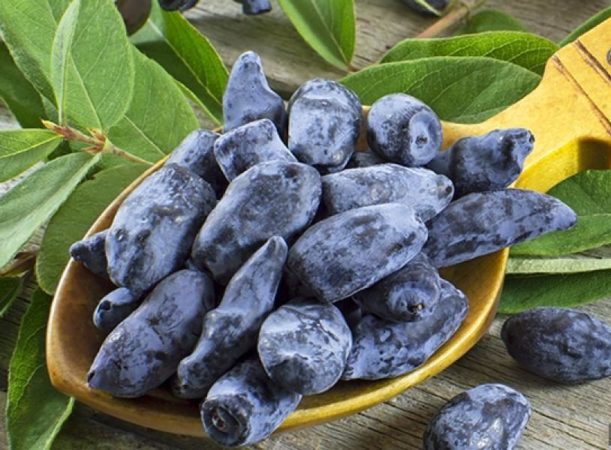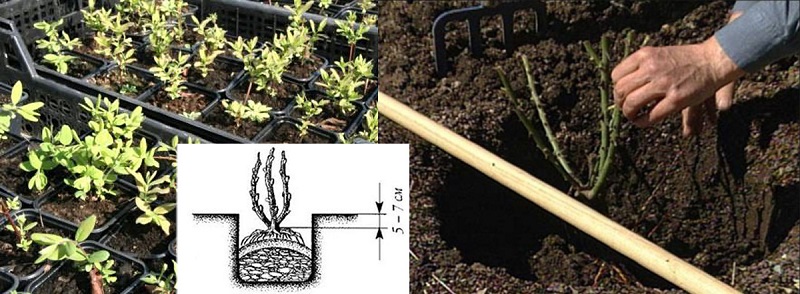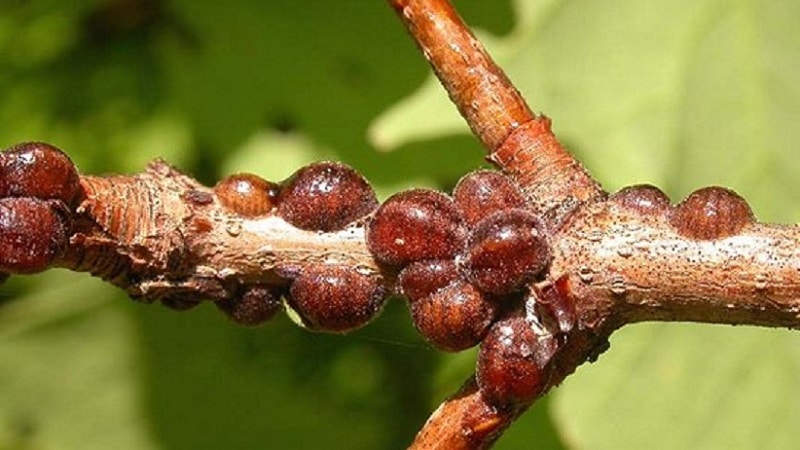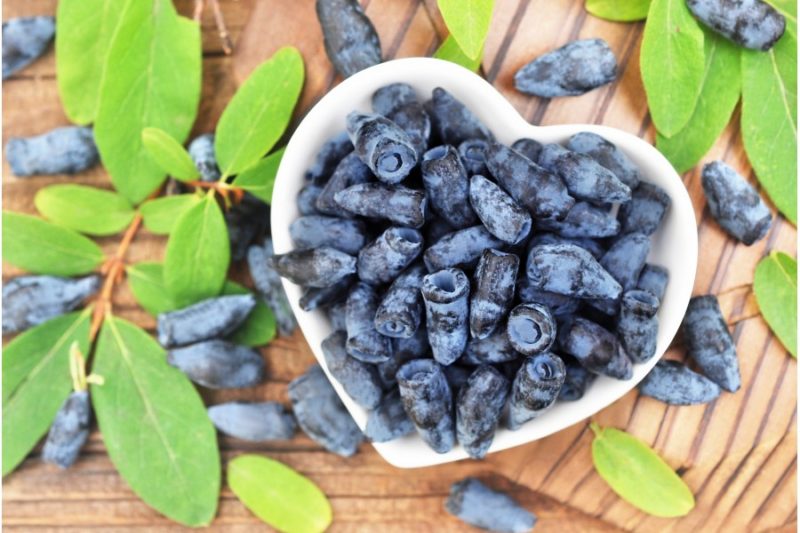Sweet unpretentious variety of honeysuckle "Lenita"
The honeysuckle variety Lenita has a pleasant sweet taste with a slight sourness, high yield, and resistance to diseases and pests. The fruits of the plant are consumed raw and used for processing into food. You will learn more about the characteristics of this variety, features of cultivation and care, and much more.
Description of the honeysuckle variety Lenita
Honeysuckle Lenita is not only a decoration for a country yard or personal plot, but also a tasty, healthy product.
Fresh berries contain ascorbic acid, B vitamins, provitamin A and a large number of microelements - iodine, phosphorus, zinc, potassium, magnesium, silicon, iron, etc.

Origin and development, history of breeding
The variety was bred in the early 90s of the last century by scientists from the Agricultural Research Center of the Russian Academy of Sciences, located in the Urals. But Lenita was added to the register of selection achievements only in 1999.
Since then, this variety of honeysuckle has received the status of a high-yielding, low-temperature-resistant, edible plant.
Characteristics, description of appearance, taste
Lenita bushes reach 1.3 m in height and form a medium-spreading, rounded crown. The shoots are thin, slightly curved, and colored reddish. The smooth leaf blades are medium in size and dark green in color. The flowers are small in size and pale in color (almost white).
Ripe berries are large, the weight of each of them reaches 1-2 g.They have an elongated oval shape and smooth, dense skin of a dark blue color, on the surface of which there is a dark gray coating. Therefore, in appearance, the fruits vaguely resemble blueberries or blueberries. The taste of the berries is sweet and sour, with a slight tartness.
Features of the use of this variety
Lenita is used for two purposes at once - to decorate the garden and for consumption. The fruits are eaten raw or made into jam, jelly, jams with the addition of other berries and fruits, compotes, etc.
Productivity and fruiting
This variety gives a good harvest. Every year, summer residents collect up to 3 kg of berries from one bush. But honeysuckle does not begin to bear fruit immediately, but only 3-4 years after planting (with proper care).
Ripening period
The berries ripen in the middle or medium-late period (depending on the climate), and this happens evenly throughout the entire crop. Thus, in warm regions, the fruits are harvested already at the end of May, and in cities with a harsher climate, the berries ripen only by mid-summer.
Resistance to diseases and pests
Lenita is resistant to many diseases and pests. The exception is fungal infections, rodent infestations or aphids.
Resistance to cold and drought
The plant tolerates winter cold well and can withstand frosts down to -5 and -7°C. A short drought is also not an obstacle to abundant flowering and fruiting (up to several days).
For which regions is it best suited and what are the climate requirements?
Lenita honeysuckle is suitable for growing in the Urals and southern Russia. The plant prefers warm and humid climates (areas with plenty of sun and minimal wind).
The main advantages and disadvantages of the variety
The advantages of this variety include the following features:
- uniform ripening of the crop;

- pleasant taste;
- no fruit shedding;
- resistance to diseases and pests;
- versatility of use;
- winter hardiness;
- ease of picking fruits (since the branches of the bush bend down on their own).
Disadvantage: Exposure to winds and heavy rains. As a result, the plant bends strongly to the ground, thin and fragile stems suffer.
What is the difference from other varieties and hybrids
Lenita differs from other varieties and hybrids of honeysuckle in its high yield, the ability to be used for various purposes (as an ornamental bush and for food), and resistance to cold, diseases and pests.
Agricultural technology
For successful cultivation of honeysuckle in the garden and good fruiting, it is important to choose the right planting site and appropriate soil, as well as provide the shrub with proper care and protection from pest invasion.
Choosing a place in the garden and preparing holes
When choosing a location and preparing holes for planting, the following recommendations will be relevant:
- It is best to plant young bushes in a place where ultraviolet rays cannot directly affect the leaves and stems. Otherwise, burns and drying of the plant are possible (due to loss of moisture in hot weather). The ideal option is a shaded area with diffused lighting.
- The recommended distance between the holes is 1.5 m. The size of each of them is 40x60x40 cm. A nutrient mixture (garden soil + potassium salt and superphosphate, 50 g of each substance) is placed at the bottom of the hole.
It is advisable to plant the plant in an area with groundwater located at a distance of at least 2 m from the top layer of soil.
Note! Before digging holes, it is important to clear the ground of plant debris (various weeds, overgrown roots of other crops, etc.).
Next, the seedlings and soil are prepared for landing.
Soil requirements
Honeysuckle grows well in light, organic-rich soil. Therefore, the soil is first loosened and 2 buckets of sand, wood ash, compost and leaf soil are added to it (for each square meter).
Dates, scheme and rules of planting

When planting honeysuckle, gardeners recommend following the following rules:
- This variety is planted either in spring or autumn. In the first case - at the end of March-beginning of April (when the snow has completely melted), and the second option - at the end of September-mid-October.
- The optimal pit depth is 40 cm, diameter is at least 60 cm.
- Each seedling is lowered into a hole (on pre-placed fertilizer), straightening the roots and avoiding creases.
- The hole is filled with earth and the soil is carefully compacted.
- Watering is carried out - at least 10 buckets of water per bush.
- Mulch the soil surface. For this purpose, organic and artificial inorganic materials are used (cut grass, straw, hay, sawdust, etc.).
- When planting honeysuckle in open ground on fertile soil, it is allowed to deepen the root collar of the seedling by 3 cm. But if the soil is heavy or there is groundwater nearby, deepening the neck is not recommended.
Knowing these rules will help you avoid common mistakes when planting.
Features of cultivation
In the first year after planting, shrubs require daily watering. First, this is done at the root and then throughout the entire planting area.The current time for the procedure is no earlier than 19:00 (when the sun's rays are low and cannot cause burns). In the next 2-3 years, watering is carried out every 1-2 days.
To accelerate growth, fertilize with fertilizers and sprinkle the bushes in the summer (through special nozzles on the hose).
Nuances of caring for honeysuckle Lenita
Honeysuckle is periodically fed with mineral fertilizers:
- in spring - urea (20 g/10 l of water, poured directly under the bush);
- before flowering - wood ash (200g/10 l of water);
- during the period of fruit formation - a mixture of potassium salt (40 g) and superphosphate (50 g).
The first pruning of the bush occurs after 5-7 years. Every spring, sanitary cleaning is carried out - weak and damaged shoots are removed. The crown is formed in the fall, as soon as the leaves fall. To do this, cut off all the growth and leave strong shoots. If necessary, shorten or trim to the base branches that have stopped growing.
Pollinators
Lenita is self-fertile, but only partially. From time to time, shrubs need cross-pollination with varieties that bloom at the same time (Gerda, Bakchar giant, Cinderella and etc.).
Disease and pest control
Despite not being resistant to diseases and pests, the plant is susceptible to fungi and aphids. The following means are used to combat parasites:
- In case of fungal infections, spray the bush with Bordeaux mixture (3%), but do this before flowering. The biological preparation “Gamair” is also relevant - 2 tablets per 10 liters of water.
- During an invasion of aphids and other leaf-eating insects, the insecticide “Agravertin” is used. It is diluted in an amount of 6 ml per 1 liter of water and processing the bushes (leaves and stems are generously moistened or sprayed).
If the drugs are ineffective or do not bring results at all, it is advisable to consult an experienced farmer.
Preparing for winter
In preparation for winter, the tree trunk circles are covered with fallen leaves (a layer of 20-30 cm). The branches are collected in early November and not tied too tightly with a bandage or clothesline. This protects the bushes from damage in the event of snowfalls and heavy rains.
Reproduction
Honeysuckle reproduces by seed and vegetative methods of propagation. In the first case, the variety does not always retain the qualities of the mother plant, but in the case of vegetative variations, the chances increase (by cuttings, layering, etc.). Here's how it's done:
- Propagation by cuttings - in summer, small green areas of the plant are planted in a container with moist soil. They are grown until next autumn.
- Propagation by layering - the lower shoot of the bush is bent to the ground and placed in a previously dug trench, securing it with a pin.

The depression is filled with soil, forming something like a mound.
Important! After a year, the rooted cuttings are carefully separated and transplanted to a new location.
Also, honeysuckle is propagated by dividing the bush.
Harvesting
The harvest is harvested by hand. The optimal time is early June to mid-July. It’s easy to determine whether a berry is ripe: if the fruit comes off easily, it means it’s ripe. The rich dark blue color also speaks in favor of ripeness.
It is best to harvest in small baskets or plastic containers.
What difficulties may there be when growing
When growing Lenita, gardeners encounter the following difficulties:
- Slow plant growth.This occurs either due to the unfortunate location of the shrub (with excess or lack of sunlight), or due to a deficiency of nutrient fertilizers.
- Eating of fruits and leaves by insects.
- Invasion of rodents (field mice, etc.).
- Drying (withering) of leaves. This happens due to a fungal infection or lack of moisture.
- Honeysuckle does not bloom leaves. Possible causes are exposure to severe frosts and the formation of cracks on stems, cancer, exposure to parasites (aphids and scale insects).
 Shchitovka
Shchitovka
If the problem is insects or fungal diseases, special medications will help correct the situation. If the sun (or its deficiency) is to blame, it is recommended to transplant the shrub to another place.
Tips and reviews from experienced gardeners about the variety

Here's what experienced gardeners say about the Lenita variety:
Elena, Orenburg: “I’ve been growing this variety for more than 10 years and I’m happy with everything. The berries are very large and sweet (with a pleasant bitterness). Every year I make jams, preserves and compote from them. To prevent the fruits from falling off, the plant requires moderate feeding (not too frequent) and the correct location.”
Vasily, Krasnodar: “There is an opinion that shriveled branches of a bush need to be pruned. But I can say from experience that this is a fallacy. If a branch is no longer growing, I cut it off at the very base. And now for many years honeysuckle has been producing a good harvest and no problems.”
Conclusion
Honeysuckle Lenita is a plant that is unpretentious to cold and drought and produces a bountiful harvest in early or mid-summer. The berries have a sweet, refreshing taste, perfectly quench thirst in hot weather and saturate the body with vitamins and microelements.
Jams, compotes are prepared from the ripened fruits of the plant, and added to baked goods.And the growing/care conditions are quite simple - timely watering, fertilizing and protection from pests.